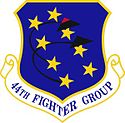| 44th Fighter Group | |
|---|---|
 F-22A Raptor assigned to the 44th Fighter Group flies over the Nevada Test and Training Range (NTTR) for a training mission during Red Flag 11-3, 2 March 2011. | |
| Active | 15 January 1941–Present |
| Country | |
| Branch | |
| Type | Group |
| Role | Fighter |
| Part of | |
| Garrison/HQ | Tyndall Air Force Base, Florida |
| Insignia | |
| 44th Fighter Group emblem |  |
| Aircraft flown | |
| Fighter | F-22A Raptor |
The 44th Fighter Group (44 FG) is an Air Reserve Component (ARC) unit of the United States Air Force. It is assigned to the Tenth Air Force, Air Force Reserve Command (AFRC), stationed at Tyndall Air Force Base, Florida. The 44 FG is an associate unit of the active duty 325th Fighter Wing (325 FW) of the Air Combat Command (ACC). If mobilized to active duty, the 44 FG is operationally gained by ACC. Otherwise, the 44 FG operates as a geographically separated unit (GSU) of AFRC's 301st Fighter Wing (301 FW) at NAS JRB Fort Worth, Texas.[1]
During World War II, its predecessor unit, the 44th Bombardment Group (44 BG), was the first VIII Bomber Command B-24 Liberator heavy bombardment group stationed in England. It was initially stationed at RAF Cheddington on 11 September 1942 and moved to RAF Shipdham in October. The 44 BG operated from England for a longer period than any other B-24 group, sustained the highest Aircraft Missing in Action losses of all Eighth Air Force B-24 groups, claimed more enemy fighters than any other Eighth Air Force B-24 group, and was the first group in the VIII Bomber Command to be awarded a Distinguished Unit Citation for actions on 14 May 1943 for an extremely hazardous mission against naval installations at Kiel, Germany
Colonel Leon W. Johnson, USAAF, while commander of the 44th Bombardment Group, was awarded the Medal of Honor for his actions during the Ploesti Raid on 1 August 1943.
In the postwar era, the 44th Bombardment Group was one of the original ten USAAF bombardment groups assigned to Strategic Air Command on 21 March 1946.
- ^ Harwood, Jennifer (12 July 2014). "'Team Tyndall': 44th Fighter Group activated in ceremony". Panama City News Herald. Retrieved 18 December 2016.